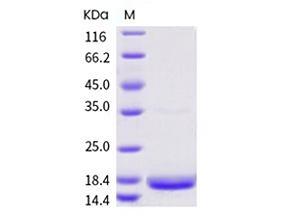Recombinant SARS-CoV-2 (2019-nCoV) NSP10 Protein
Purity
> 95 % as determined by SDS-PAGE.
Endotoxin
Please contact us for more information.
Activity
Testing in progress
Protein Construction
A DNA sequence encoding the SARS-CoV-2 (2019-nCoV) NSP10 (YP_009725306.1) (Ala1-Gln139) was expressed with two amino acids (GP) at the N-terminus.
Accession#
Expressed Host
E. coli
Species
SARS-CoV-2
Predicted N Terminal
Gly
Molecule Mass
The recombinant SARS-CoV-2 (2019-nCoV) NSP10 Protein consists of 141 amino acids and predicts a molecular mass of 15 kDa.
Formulation
Lyophilized from sterile 20 mM Tris, 500 mM NaCl, pH 7.4.
Please contact us for any concerns or special requirements.
Normally 5 % – 8 % trehalose, mannitol and 0.01% Tween80 are added as protectants before lyophilization.
Please contact us for any concerns or special requirements.
Normally 5 % – 8 % trehalose, mannitol and 0.01% Tween80 are added as protectants before lyophilization.
Please refer to the specific buffer information in the hard copy of CoA.
Shipping
In general, recombinant proteins are provided as lyophilized powder which are shipped at ambient temperature.
Bulk packages of recombinant proteins are provided as frozen liquid. They are shipped out with blue ice unless customers require otherwise.
Bulk packages of recombinant proteins are provided as frozen liquid. They are shipped out with blue ice unless customers require otherwise.
Stability & Storage
Samples are stable for up to twelve months from date of receipt at -20℃ to -80℃. Store it under sterile conditions at -20℃ to -80℃. It is recommended that the protein be aliquoted for optimal storage. Avoid repeated freeze-thaw cycles.
Reconstitution
A hardcopy of datasheet with reconstitution instructions is sent along with the products. Please refer to it for detailed information.
Recombinant SARS-CoV-2 (2019-nCoV) NSP10 Protein 圖片

Coronavirus NSP10 Background Information
NSP10 is a major regulator of coronavirus replicase function. NSP10 contains two zinc fingers and binds and stimulates both NSP14 and NSP16 activities. Researchers has found that the nsp10 surface that interacts with nsp14 and nsp16 and possibly other subunits of the viral replication complex may be a target for the development of antiviral compounds against pathogenic coronaviruses.
